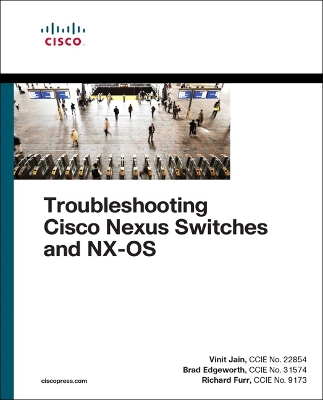Networking Technology
2 total works
Troubleshooting Cisco Nexus Switches and NX-OS
by Vinit Jain, Bradley Edgeworth, and Richard Furr
The definitive deep-dive guide to hardware and software troubleshooting on Cisco Nexus switches
The Cisco Nexus platform and NX-OS switch operating system combine to deliver unprecedented speed, capacity, resilience, and flexibility in today's data center networks. Troubleshooting Cisco Nexus Switches and NX-OS is your single reference for quickly identifying and solving problems with these business-critical technologies.
Three expert authors draw on deep experience with large Cisco customers, emphasizing the most common issues in real-world deployments, including problems that have caused major data center outages. Their authoritative, hands-on guidance addresses both features and architecture, helping you troubleshoot both control plane forwarding and data plane/data path problems and use NX-OS APIs to automate and simplify troubleshooting. Throughout, you'll find real-world configurations, intuitive illustrations, and practical insights into key platform-specific behaviors.
This is an indispensable technical resource for all Cisco network consultants, system/support engineers, network operations professionals, and CCNP/CCIE certification candidates working in the data center domain.
· Understand the NX-OS operating system and its powerful troubleshooting tools
· Solve problems with cards, hardware drops, fabrics, and CoPP policies
· Troubleshoot network packet switching and forwarding
· Properly design, implement, and troubleshoot issues related to Virtual Port Channels (VPC and VPC+)
· Optimize routing through filtering or path manipulation
· Optimize IP/IPv6 services and FHRP protocols (including HSRP, VRRP, and Anycast HSRP)
· Troubleshoot EIGRP, OSPF, and IS-IS neighbor relationships and routing paths
· Identify and resolve issues with Nexus route maps
· Locate problems with BGP neighbor adjacencies and enhance path selection
· Troubleshoot high availability components (BFD, SSO, ISSU, and GIR)
· Understand multicast protocols and troubleshooting techniques
· Identify and solve problems with OTV
· Use NX-OS APIs to automate troubleshooting and administrative tasks
Cisco Intelligent WAN (IWAN)
by Bradley Edgeworth, David Prall, Jean Marc Barozet, Anthony Lockhart, and Nir Ben-Dvora
The complete guide to Cisco® IWAN: features, benefits, planning, and deployment
Using Cisco Intelligent WAN (IWAN), businesses can deliver an uncompromised experience, security, and reliability to branch offices over any connection. Cisco IWAN simplifies WAN design, improves network responsiveness, and accelerates deployment of new services. Now, there’s an authoritative single-source guide to Cisco IWAN: all you need to understand it, design it, and deploy it for maximum value.
In Cisco Intelligent WAN (IWAN), leading Cisco experts cover all key IWAN technologies and components, addressing issues ranging from visibility and provisioning
to troubleshooting and optimization. They offer extensive practical guidance on migrating to IWAN from your existing WAN infrastructure.
This guide will be indispensable for all experienced network professionals who support WANs, are deploying Cisco IWAN solutions, or use related technologies such as DMVPN or PfR.
- Deploy Hybrid WAN connectivity to increase WAN capacity and improve application performance
- Overlay DMVPN on WAN transport to simplify operations, gain transport independence, and improve VPN scalability
- Secure DMVPN tunnels and IWAN routers
- Use Application Recognition to support QoS, Performance Routing (PfR), and application visibility
- Improve application delivery and WAN efficiency via PfR
- Monitor hub, transit, and branch sites, traffic classes, and channels
- Add application-level visibility and per-application monitoring to IWAN routers
- Overcome latency and bandwidth inefficiencies that limit application performance
- Use Cisco WAAS to customize each location’s optimizations, application accelerations, and virtualization
- Smoothly integrate Cisco WAAS into branch office network infrastructure
- Ensure appropriate WAN application responsiveness and experience
- Improve SaaS application performance with Direct Internet Access (DIA)
- Perform pre-migration tasks, and prepare your current WAN for IWAN
- Migrate current point-to-point and multipoint technologies to IWAN

